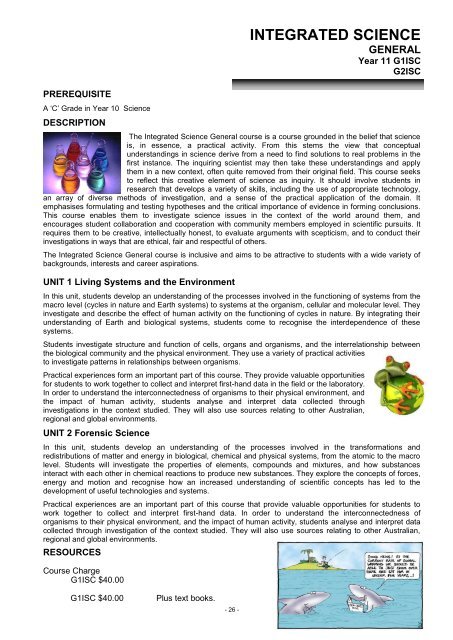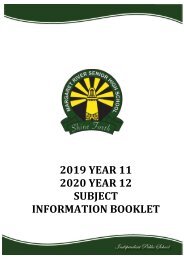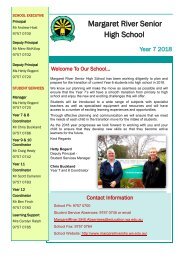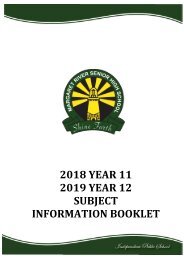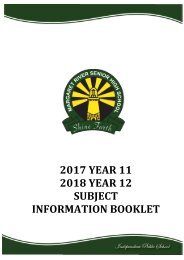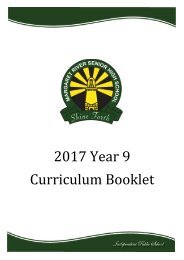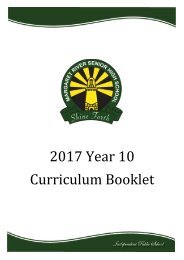2017 Upperschool Course Information
You also want an ePaper? Increase the reach of your titles
YUMPU automatically turns print PDFs into web optimized ePapers that Google loves.
PREREQUISITE<br />
A ‗C‘ Grade in Year 10 Science<br />
DESCRIPTION<br />
INTEGRATED SCIENCE<br />
GENERAL<br />
Year 11 G1ISC<br />
G2ISC<br />
The Integrated Science General course is a course grounded in the belief that science<br />
is, in essence, a practical activity. From this stems the view that conceptual<br />
understandings in science derive from a need to find solutions to real problems in the<br />
first instance. The inquiring scientist may then take these understandings and apply<br />
them in a new context, often quite removed from their original field. This course seeks<br />
to reflect this creative element of science as inquiry. It should involve students in<br />
research that develops a variety of skills, including the use of appropriate technology,<br />
an array of diverse methods of investigation, and a sense of the practical application of the domain. It<br />
emphasises formulating and testing hypotheses and the critical importance of evidence in forming conclusions.<br />
This course enables them to investigate science issues in the context of the world around them, and<br />
encourages student collaboration and cooperation with community members employed in scientific pursuits. It<br />
requires them to be creative, intellectually honest, to evaluate arguments with scepticism, and to conduct their<br />
investigations in ways that are ethical, fair and respectful of others.<br />
The Integrated Science General course is inclusive and aims to be attractive to students with a wide variety of<br />
backgrounds, interests and career aspirations.<br />
UNIT 1 Living Systems and the Environment<br />
In this unit, students develop an understanding of the processes involved in the functioning of systems from the<br />
macro level (cycles in nature and Earth systems) to systems at the organism, cellular and molecular level. They<br />
investigate and describe the effect of human activity on the functioning of cycles in nature. By integrating their<br />
understanding of Earth and biological systems, students come to recognise the interdependence of these<br />
systems.<br />
Students investigate structure and function of cells, organs and organisms, and the interrelationship between<br />
the biological community and the physical environment. They use a variety of practical activities<br />
to investigate patterns in relationships between organisms.<br />
Practical experiences form an important part of this course. They provide valuable opportunities<br />
for students to work together to collect and interpret first-hand data in the field or the laboratory.<br />
In order to understand the interconnectedness of organisms to their physical environment, and<br />
the impact of human activity, students analyse and interpret data collected through<br />
investigations in the context studied. They will also use sources relating to other Australian,<br />
regional and global environments.<br />
UNIT 2 Forensic Science<br />
In this unit, students develop an understanding of the processes involved in the transformations and<br />
redistributions of matter and energy in biological, chemical and physical systems, from the atomic to the macro<br />
level. Students will investigate the properties of elements, compounds and mixtures, and how substances<br />
interact with each other in chemical reactions to produce new substances. They explore the concepts of forces,<br />
energy and motion and recognise how an increased understanding of scientific concepts has led to the<br />
development of useful technologies and systems.<br />
Practical experiences are an important part of this course that provide valuable opportunities for students to<br />
work together to collect and interpret first-hand data. In order to understand the interconnectedness of<br />
organisms to their physical environment, and the impact of human activity, students analyse and interpret data<br />
collected through investigation of the context studied. They will also use sources relating to other Australian,<br />
regional and global environments.<br />
RESOURCES<br />
<strong>Course</strong> Charge<br />
G1ISC $40.00<br />
G1ISC $40.00<br />
Plus text books.<br />
- 26 -


